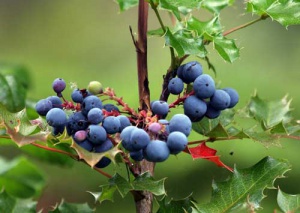Oregon Grape
Contents
Description & Habitat
Oregon Grape is also known as Oregon Grape root and mountain grape. It's an evergreen shrub with dark green shiny leaves that resemble holly. It's flowers are yellowish green in color, and its berries which are grown in small clusters are a dark purple or blue. The root of the Oregon Grape is bright yellow in color, and contains high amounts of berberine (alkaloid), it is most used for medicinal purposes, along with the plant rhizome.
This herb is widely used in gardens and landscaping, and found mainly in North America, specifically Oregon, but is found anywhere along the Pacific Northwest from Northern California to Southern British Columbia.
Constituents & Actions
Oregon Grape contains alkaloids of the isoquinoline type, berberine, hydrastine and oxycanthine. It acts as an alterative (cleanser, aids in removal of waste products), cholagogue (stimulated bile flow from the gall bladder and bile dicts into the duodenum), antiseptic, laxative, anti-emetic (lessens nausea, prevents or relieves vomiting), anti-catarrhal (eliminates mucus conditions) and tonic. It is very similar in action to goldenseal and barberry.
Medicinal Uses
This herb is most noted for its use in problems relating to the skin, such as psoriasis and eczema. When combined with burdock root, yellow dock and cleavers, it is especially helpful in the treatment of many skin disorders.
Oregon Grape is very effective as a tonic for liver, gall-bladder and spleen. It is beneficial for catarrhal disorders of the stomach, intestines and urinary organs. It aids in poor digestion, headaches and is considered to be an excellent blood purifier.
Culinary Uses
Although the berries of the Oregon Grape are tart and slightly bitter, they are rich in pectin and make a fine jelly or jam, which is appreciated due to its spicy grape-like flavor. It is also used in the making of wines and juices. An extra benefit is a high vitamin C content.
Preparation, Dosage & Side-Effects
A decoctin can be made by mixing 1-2 tsp. fo the root in one cup of water, bring to a boil and then simmer for 10-15 minutes, drink 3x's per day. The tincture, in the dose of 1-4ml, may be taken three times daily.
The side-effects of this herb are rare, excessive use may cause diarrhea or kidney inflammation. Women who are pregnant should not use Oregon Grape because it may promote uterine contractions.
